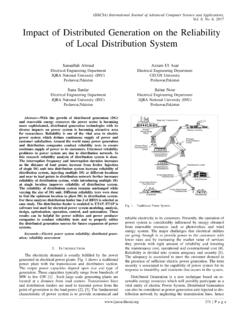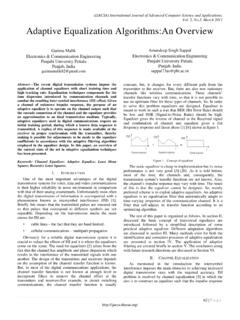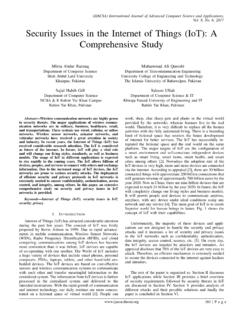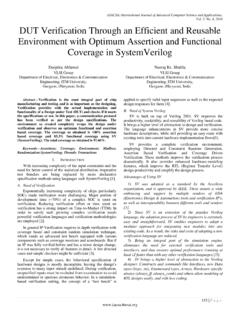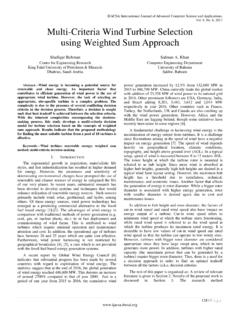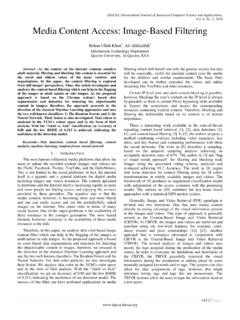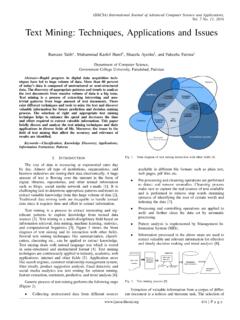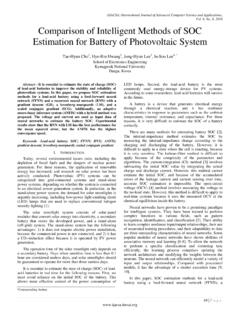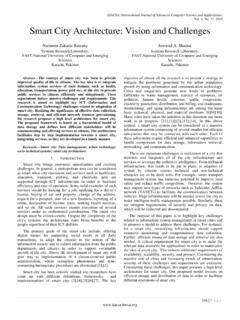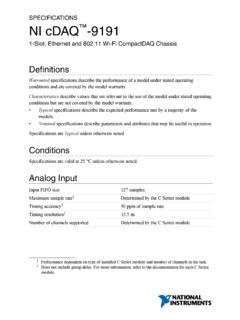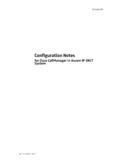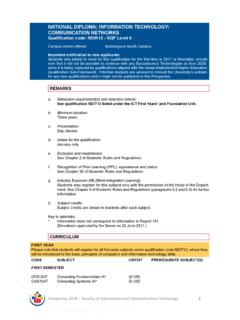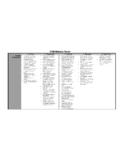Transcription of Improving Performance Analysis Of Routing …
1 (IJARAI) International Journal of Advanced Research in Artificial Intelligence, Vol. 1, No. 2, 2012 45 | P a g e Improving Performance Analysis Of Routing Efficiency In Wireless Sensor Networks Using Greedy Algorithm Dr. VUDA SREENIVASARAO1 Professor, Dept. of CIT Defence University College, Deberezeit. Ethiopia. CHANDRA SRINIVAS POTLURI2 Asst Professor, Dept. of CSE Aurora Sci Tech& Research Academy Hyderabad, India. SREEDEVI KADIYALA3 Lecturer, Dept. of CSE Jigjiga University, Jigjiga. Ethiopia Capt. GENETU YOHANNES4 HOD, Dept. of CIT Defence University College, Deberezeit,Ethiopia. Abstract: The void problem causing the Routing failure is the main challenge of the greedy Routing in the wireless sensor networks.
2 The current research work still cannot fully deal with the void problem since the excessive control overheads should be consumed so as to guarantee the delivery of packets. In this paper the solution to the void problem is taken up as the issue. This situation exists in the currently existing greedy Routing algorithms in wireless sensor networks. The GAR protocol is a new protocol proposed here to guarantee the delivery of packets and excessive consumption of control overheads is resolved. Keywords: Greedy Routing ; void problem; localized algorithm; wireless sensor network.
3 I. INTRODUCTION Wireless sensor networks consist of a large number of inexpensive sensor nodes distributed in environment uniformly, having limited energy, therefore, in the most cases, nodes communicate with central node via their neighbours. On the other hand, an optimal route must be selected because there are different routes to central node from any other nodes. On the other hand, frequent use of one route results in reduction of energy of sensors located on that route and, ultimately, in sensors destruction. For solving this problem, we can consider a wireless sensor network as a graph in the nodes (hosts) which are the sensors and edges show the links between sensors.
4 Wireless sensor networks are currently using in different fields of research in both academic and industry. A wireless sensor networks is composed of a large number of nodes that are choose randomly dispersed over some of the interest area. Here all nodes in a wireless networks not communicate directly, so a multi hop Routing protocol concept is required. Most of the Routing protocols in wireless networks have been designed for networks of some number of hundreds of nodes and do not scale to networks with thousands of nodes. Sensors combined in to machinery, environment, structures, coupled with the effective delivery of sensed information, could provide best benefits to society.
5 The wireless sensor is networked and scalable, consumes very little power, it is software programmable and smart, it is good capable of speed data acquisition, reliable and accurate over the long term, costs little to purchase and install, and requires no real maintenance. This capability is enabling networks of very low cost sensors that are able to communicate with each other using low power wireless data Routing protocols. A wireless sensor network generally consists of a base station can be communicate with a number of wireless sensors via a radio link. Data is collected at the wireless sensor node, compressed and transmitted to the gateway directly or, if required, uses other wireless sensor nodes to forward data to the gateway.
6 The transmitted data is presented to the system by the base station connection. A wireless sensor network (WSN) consists of sensor nodes (SNs) with wireless communication capabilities for specific sensing tasks. Due to the limited available resources, efficient design of localized multi hope Routing protocols becomes a crucial subject within the WSNs. How to guarantee delivery of packets is considered an important issue for the localized Routing algorithms. The well-known greedy forwarding (GF) algorithm is considered a superior scheme with its low Routing overheads. However, the void problem, which makes the GF technique unable to find its next closer hop to the destination, will cause the GF algorithm failing to guarantee the delivery of data packets.
7 Next generation environments represent the next evolutionary development step in utilities, building, home, industrial, shipboard, and transportation systems automation. Sensor network data comes from multiple sensors of different modalities in distributed in different locations. (IJARAI) International Journal of Advanced Research in Artificial Intelligence, Vol. 1, No. 2, 2012 46 | P a g e Routing algorithms are proposed to either resolve or reduce the void problem, which can be classified into non-graph-based and graph-based schemes. In the non-graph- based algorithms, the intuitive schemes as proposed in construct a two-hop neighbor table for implementing the GF algorithm.
8 The network flooding mechanism is adopted within the GRA and PSR schemes while the void problem occurs. There also exist Routing protocols that adopt the backtracking method at the occurrence of the network holes (such as GEDIR, , DFS , and SPEED ). The Routing schemes as proposed by ARP and LFR memorize the Routing path after the void problem takes place. Moreover, other Routing protocols (such as PAGER NEAR and YAGR) propagate and update the information of the observed void node in order to reduce the probability of encountering the void problem. By exploiting these Routing algorithms, however, the void problem can only be either 1) partially alleviated or 2) resolved with considerable Routing overheads and significant converging time.
9 Several Routing algorithms are proposed to either resolve or reduce the void problem, which can be classified into non-graph-based and graph-based schemes. In the non-graph- based algorithms [3], [4], [5], [6], [7], [8], [9], [10], [11], the intuitive schemes as proposed in [3] construct a two-hop neighbor table for implementing the GF algorithm. The network flooding mechanism is adopted within the GRA [4] and PSR schemes while the void problem occurs. There also exist Routing protocols that adopt the backtracking method at the occurrence of the network holes (such as GEDIR, [3], DFS [5], and SPEED [6]).
10 The Routing schemes as proposed by ARP and LFR memorize the Routing path after the void problem takes place. Moreover, other Routing protocols (such as PAGER [7], NEAR [8], DUA [9], INF [10], and YAGR [11]) propagate and update the information of the observed void node in order to reduce the probability of encountering the void problem. By exploiting these Routing algorithms, however, the void problem can only be either 1) partially alleviated or 2) resolved with considerable Routing overheads and significant converging time. The Gabriel graph (GG) and the relative neighborhood graph (RNG) are the two commonly used localized planarization techniques that abandon some communication links from the UDG for achieving the planar graph.
